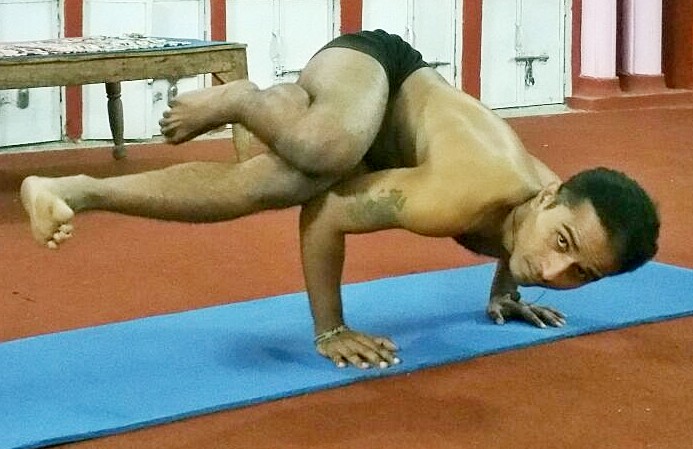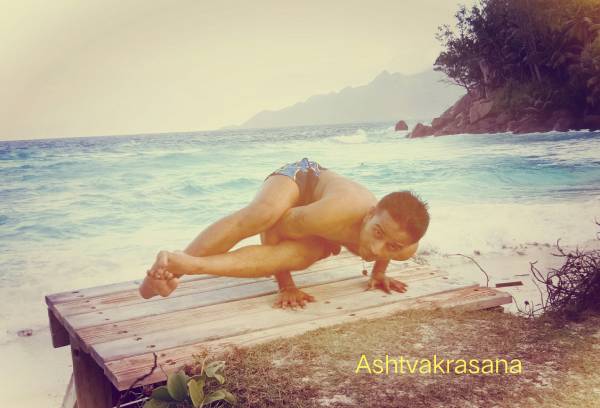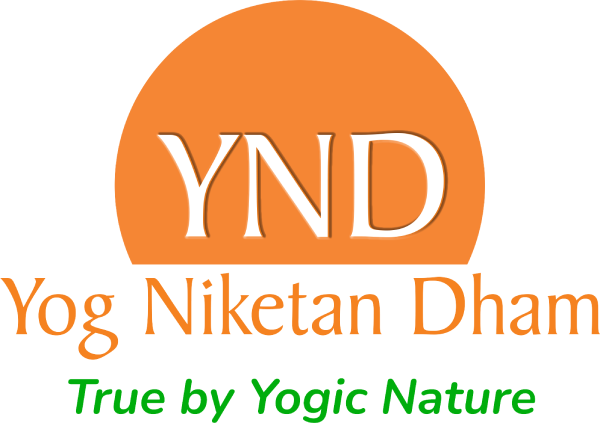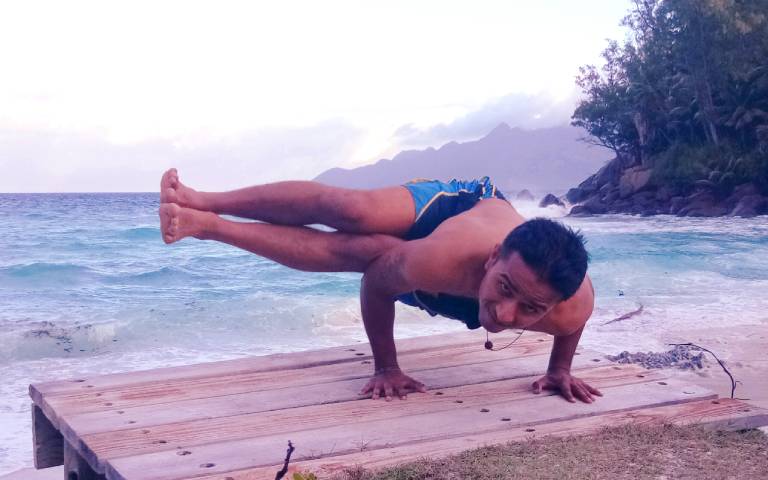Astavakrasana
Table of Contents
Astavakrasana, or the Eight-Angle pose, was named after a noble Yogi Ashtavakra. The eight-angle pose is mainly practiced in the Hatha yoga practice. There is a magical energy work after practicing Astavakrasana.
He was the son of King Kagola, who cursed him for having curves on his body when he was in his mother’s womb.

In Sanskrit, Ashta means eight, and Vakra is called bends. Ashtvakra means eight turns.
Ashtvakrasana is a balancing pose under an advanced series of Hatha Yoga practices. This posture is excellent for awakening the Manipur chakra and helps people improve their concentration levels.
It would help if you practiced this asana after balancing the palms, which requires a lot of strength on the forearms and elbows. Before attempting it, we highly recommend practicing Bakasana and Chaturanga Dandasana.
How to practice Astavakrasana or Eight-Angle Pose?
Eight-angle pose should be practiced in asanas after proper warm-up and finishing the primary series of Asanas. Before you try this posture, please check the appropriate alignment of body parts.
There should be a lot of practice in wrist movements, shoulder rotation, elbow extensions, and arm stretching. The sequence of practicing Astavakrasana will be as follows: –
- It balances on palms, and there should be enough practice of Crow Pose. Then, finally, it prepares the body to adopt the Eight-Angle pose.
- Take all your body weight on your forearms, lean forward, and pay attention to the forefingers. It is required to make a firm grip over there.
- After bending your elbows, twist the lower back and place one of the hips on the alternative elbow.
- Slightly lift one of your legs, make proper balance on the palms, and lift another leg.
- As both legs are together, shift the body weight on the arms. Again, It is imperative to bring full attention to it.
- Hold an eight-angle pose for 20 to 30 seconds; make your breath more profound, and do not push the Sacrum. Next, enlarge your spinal cord and release pressure from the lumbar region.

Benefits of Astavakrasana or Eight-Angle pose
The eight-angle pose requires a lot of strength, resistance, power, balance, and flexibility. There are many benefits of Ashtvakrasana, and these are: –
- It develops arm muscles and strengthens the wrists and elbows.
- The eight-angle pose is an advanced posture for boosting energy in the lower body parts.
- Astavakrasana has excellent work on developing concentration levels. It also makes a practitioner confident in Asanas practice.
- This posture is very effective for toning the abdominal muscles.
- It increases the flexibility of the physical body and sharpens the mind.
- Astavakrasana is adequate for good shape on the Deltoid, Scapula, Triceps, and Internal Oblique muscles.
- There is fast blood circulation in the abdomen, which is very effective for the intestines and spleen.
- Astavakrasana activates the Mooladhara (root channel) and Manipur Chakra (solar-plexus channel).
- It effectively reduces back pain and removes the slip disk problem effectively.
- It makes the spinal cord flexible and allows blood to circulate in the Pelvis.
- It is also very effective in Kundalini awakening.
- Astavakrasana improves eyesight and gives clear vision.
- It comes under advanced asanas practice, which prepares a person to practice other postures.
- The eight-angle pose works perfectly on the shoulder area and for their strengthing. Precautions
- Persons who are suffering from broken wrists should not attempt it.
- Astavakarasana is an advanced posture that may be tried after properly warming the body parts.
- People suffering from lower back problems should practice it with less holding.
- Sometimes, if you feel dizzy during practice, you may stop the practice immediately.
- If there is any stomach-related surgical issue, please avoid it.
- Beginners should also not force themselves to practice Astvakrasana; they should always practice it under proper supervision.
- In the case of a fracture in the hand, one should not practice it.
- Practicing with less holding and less pressure is advisable in a hip injury.
Note: The eight-angle pose is used in Yoga Therapy as an effective tool for recovering from back and shoulder injuries.
Tags:


